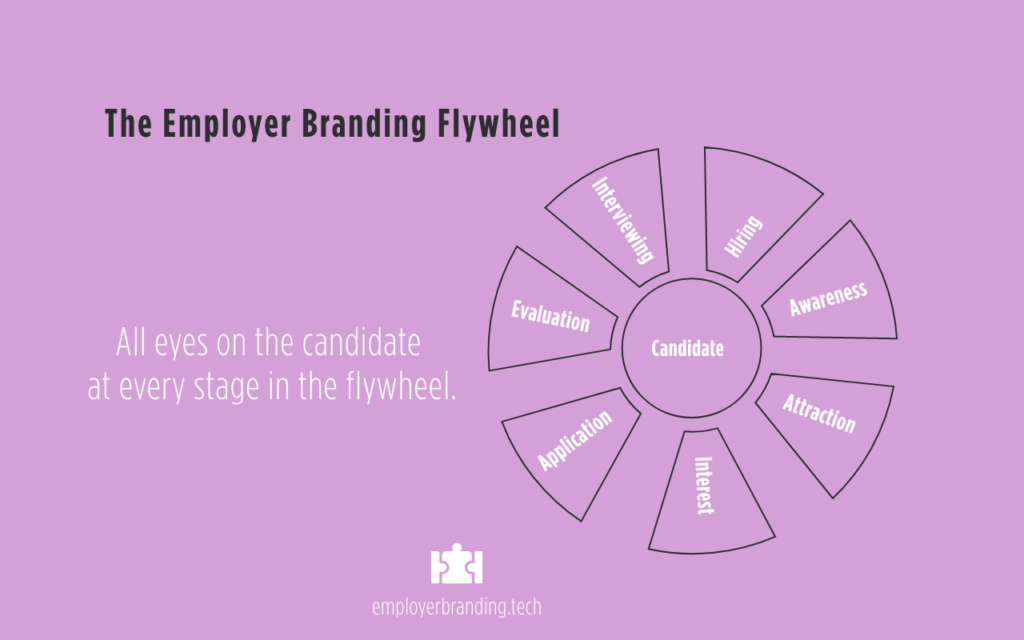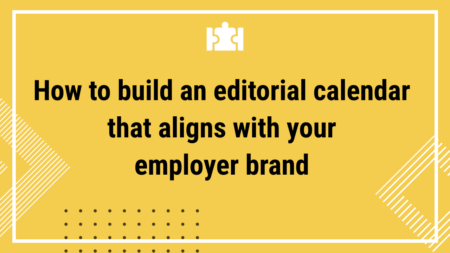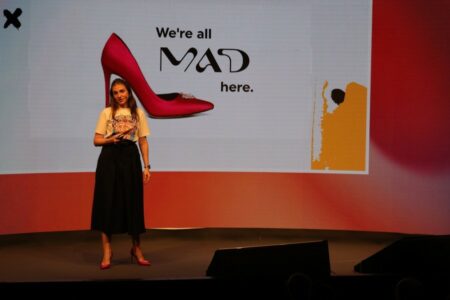In recruitment marketing, “funnel” is actually the process of narrowing down an audience. Similar to the inbound marketing funnel, the target audience in recruitment is the candidate persona rather than the buyer persona. The aim is to build a pipeline of qualified candidates so that HR departments can find the ones that fit their company’s open job roles.
What does a candidate who “fits” a certain role look like? It all started when companies realized that the “best” candidates are the ones that matched their values, their DNA, in one word, their culture.
Having a strong company culture quickly became a “selling” point for companies eager to hire the brightest candidates the market had to offer. Up until 2020, the recruitment marketing funnel worked wonderfully. HR leaders knew what to do to entice their target audience, make them curious and interested in what the company had to offer, and eventually convince them to apply.
Now, in 2022, it seems that the funnel keeps getting clogged. Whether at the very top, in the middle, or at the bottom, traditional recruitment marketing has been dismantled. The pandemic served as a catalyst for the numerous “strong” company cultures out there. It led to a boom in resignations, inevitably revealing that values like “autonomy”, “transparency”, “flexibility”, “openness”, and others, were just a facade.
And yet, the recruitment marketing funnel still works – to some degree. Some companies may not have an issue with attraction, but with retention. Others may have issues in the interview or even the hiring stage. Regardless, upon hiring, new employees quit in less than 6 months. They do it because now they know they have options. They’ve become aware of their value and aren’t afraid to speak up.
While the candidate job market continues to bloom, a concept that was treated superficially before 2020 is now the hottest topic in HR: employer branding.
If marketing is a numbers game, employer branding is a people’s game. You don’t want the “more” but the “better”. “Wanting better means being willing to reject lots more. It means being selective and most companies are so terrified that some diamond in the rough is going to look at their website and say ‘Oh, you said a word I don’t like. I’m gone.’”. – James Ellis.
In an attempt to revamp the funnel and make it efficient again, a recruitment marketing flywheel seems to make a lot more sense. In a flywheel, the candidate remains at the center of the recruiting process, or better said, at the center of your employer branding initiatives.
Here’s how we see the employer branding flywheel:

#1 Awareness
“Look outside and you will see yourself. Look inside, and you will find yourself.”
To recruit better, organizations should become more aware of their strengths, weaknesses, and challenges. To find and address them, you have to look inside your company. Start by conducting an employee survey to frame an EVP (employee value proposition).
Conducting an employee survey is the first step in building employer brand awareness around the candidate persona. It’s not an HR tool that you use only when you need to recruit, but an ongoing effort that will help you acknowledge where you stand as an employer.
The purpose of an employee survey is to get at the core of what makes employees stay with your company. It’s not an easy job because you have to find reasons that are unlike any other company’s reasons; something that makes you unique.
Once you’ve pinned down your uniqueness, reinforce awareness by building a story. A well-defined brand story enables you to build a comprehensive employer branding strategy that lives on through the stories you tell.
“People want to work with people that they can connect and feel connected to. It’s the story that gets your message across in a way that’s more clear, more memorable, and easier to understand. In any place you’re trying to build relationships with people, storytelling can have a powerful impact.”
Mark Carpenter, Author of Master Storytelling
Just like with any story, to make it into a successful narrative you need a blueprint. In the context of employer branding, that blueprint pins down the key aspects of your business: principles, values, competencies, and product design. Once your story’s skeleton is in place, communication becomes the main driver of success. Your story must be capable of opening a conversation, meaning the way you do employer branding must use storytelling as a call to action.
Key takeaways
To build brand awareness from the get-go, don’t take your eyes off the candidate and:
- Frame an EVP to know what makes your company unique
- Leverage your unique traits to pin down company values
- Build a story around your values
- Use storytelling as a call-to-action to attract (Stage #2)
#2 Attraction
“Just like a magnet, like attracts like! “
In the attraction stage, the EVP, UVP, values, and story built in awareness join forces to become a framework for the in-depth promotion of your employer brand; a framework that begins to focus more on job roles that must be filled. It’s a stage in the flywheel that targets job descriptions, targeted employer branding campaigns, and paid social media ads.
Define your candidate persona(s) at the center of the flywheel. Who is the ideal job candidate? Following this step, write content with candidate persona in mind. Your initiatives (e.g. job descriptions, ads) must be segmented and targeted to fit people’s individual needs and wants.
For example, if your candidate personas are looking for education and career growth, your job descriptions or employer branding campaign should mention your company has an L&D program in place. When in doubt, leverage the EVP (employee value proposition) and UVP (unique value proposition) framed in the #1 Awareness stage.
Caution! It’s easy to get lost in Attraction, and you don’t want to emphasize unrealistic perks and benefits. Given the market know-how, candidates have today, sooner or later they’ll spot the lies.
Let’s face it, everybody lies, including candidates. Rather than get mixed up in a rollercoaster of lies, be honest. Every job comes with both benefits and challenges, and if you want the right people to stay with your company, mentioning those challenges will attract candidates capable of solving them.
In a recent episode of our podcast, employer branding specialist, James Ellis, talked about the importance of not focusing on the more, but on the better. Deep down, no company wants 1000 people to apply to a job post, but only 2 as long as they’re great. However, many get stuck in #1 Awareness, in the fantasy that if they get 1000 applicants, 1000 likes, and 1000 reactions, their campaign is working. It’s not because you’re lying!
For Attraction to move the flywheel in the right direction (stage 3# Interest), you must:
“Accurately describe the job, the company, and the culture. Sometimes, every job sucks. It’s hard, annoying, frustrating, and painful. The fastest way to attract the right people is to say in every job post the reason why the job is hard. Is it politics, a process, the people, or the product? Because every strength is a weakness, every weakness is a strength. Every job no matter how amazing has to suck.”
James Ellis, employer brand/talent strategy thinker, keynote speaker, and host @The Talent Cast
Chances are that a lot of potential talent in your pool will walk away. And that’s ok. This is where recruiters enter panic mode because their responsibility is to collect and trim resumes. The main difference between the recruitment marketing funnel and the employer branding flywheel is that the latter focuses on quality, not quantity.
For decades, recruitment marketing has been focusing too much on the mechanics of the funnel. Recruiters inflate job descriptions without knowing what the job is about. On top of that, job descriptions look like patched-up grocery lists that make no sense.
Key takeaways
For Attraction to work, you need to:
- Be brutally honest about the good, the bad, and the challenging parts of a job role
- Focus less on quantity and more on quality
- Trust that your EVP, values, and culture will attract the right people
- Believe that like that attracts like builds interest (Stage #3)
#3 Interest
“Your brand is what your business does, reputation is what people remember.”
By now, passive candidates should know who you are and what you’ve got to offer. The Interest stage focuses on how interesting your offer is, steadily compelling candidates to take action for the first time. Don’t get your hopes too high, though. They’re not ready to apply, yet. They will, however, begin to do some research into your company (e.g. company website analysis, About us page, Career Page, Glassdoor reviews, social media activity).
What type of content about you will the candidate find on social media? How frequently do you post on LinkedIn? How’s your star rating on Glassdoor? When was the last time you updated your website’s content? Do you have a Career Page and is it visible and user-friendly?
In this stage of the flywheel, your brand reputation will help candidates decide whether or not to apply. Assuming that your content is already up to date, be prepared to answer questions from potential candidates. They might reach out via social media just to ask for more information regarding your culture, work environment, or open roles.
Because you don’t want to be caught off guard, the FAQ section of your website must also be updated. Furthermore, it’s highly recommended to answer questions quickly on Facebook, Instagram, or LinkedIn. On a more personal note, the person handling the communications aspect of this stage should be a people person capable of showing empathy. It’s best to not assume anything and become open to having a conversation with another human being.
Key takeaways
The Interest stage of the flywheel is an opportunity to connect with candidates on either a personal or professional level. To get closer and succeed at building a connection, you should:
- Answer questions promptly with honesty
- Be kind and empathic
- Have an updated FAQ section on your website
- Be easy to reach out to (e.g. Chabot, live messaging, phone, email)
- Not force the conversion and rush the potential candidate to apply (#4 Application)
#4 Application
“Subtract the obvious, add the meaningful.”
Congrats on your 1st “Apply Now” click! If you made it this far, it means that all the effort put into #1 Awareness, #2 Attraction, and #3 Interest has paid off. But don’t get too excited! This stage is known to have high attrition in the recruitment process. To make sure that doesn’t happen, Application is the stage where your focus should be on creating a memorable candidate experience.
According to Careerbuilder, 60% of job seekers who hit the “Apply Now” button drop out because the process of applying to an open role is too complex. How do you move interested applicants through the flywheel so that they reach #5 Evaluation?
Let’s start with a big DON’T! Don’t make the application process content-heavy. Indeed.com research shows that 40% of interested candidates drop out instantly if they must go through 20 screening questions. Content-heavy job descriptions and elaborate questions create resistance, deterring candidates from the actual job role, no matter its greatness. Content matters just as much as context in this phase, so make it meaningful not obvious.
“The recruitment funnel is a heuristic. It’s a quick way of understanding a complicated model. But if you understand that someone has heard about your company, has read your job posting, has watched a video, and has clicked apply, you now know who they are, what they’re here for, and what they’ve seen. You can estimate or guess what they saw that made them go, ‘Oh, yeah, I want some of that. If they saw a video about how the company is growing fast, this is a person who wants to join a fast-growing company, all of your messages should feed that idea.”
James Ellis, employer brand/talent strategy thinker, keynote speaker, and host @The Talent Cast
Key takeaways
Think less about the need to fill an open role and more about the experience of the candidate:
- Make sure the application process is straightforward & optimized for mobile
- Use simple language & short sentences
- Triple check the job description & keep things short and sweet
- Test the application & make sure it doesn’t take longer than 5 minutes to complete
- End the application with a skill test CTA rather than a request to upload a resume. This way, you increase your chances of moving candidates to the evaluation stage (#5 Evaluation)
#5 Evaluation
“Honesty saves everyone’s time.”
If you opted for a skill test CTA rather than a resume in the #4 Application stage, you most likely didn’t get 100 applications, but 5, at the top. Screening out of 5 candidates becomes a lot easier as it allows you to know faster whether or not a candidate’s experience matches the role that needs to be filled.
However, let’s face it! Most recruiters and HR professionals want to have options, and the majority still believe that a request for a resume at the end of the application process is the best approach.
Regardless of your CTA in #4 Application, the screening process needs to be conducted with great care. Tough decisions will have to be made, and if you don’t pay enough attention you may fall into an unconscious bias mode. Bias is deceiving as it may lead to screening out quality candidates that match the open role, the company culture, mission, values, and the work environment.
Believe it or not, resume screening – although quite popular – is a flawed recruiting technique. Candidates lie a lot and academic credentials don’t necessarily predict future job success. Also, manual resume screening is a time-consuming process that most recruiters treat superficially, their main focus being on the technical skills of an applicant.
Skill testing, on the other hand, saves time. It’s a more efficient screening technique because it helps recruiters rank candidates with precision. It tells a lot about an applicant’s strengths and weaknesses, enabling HR managers to explore them further in the #6 Interview stage.
“The recruitment process is a direct representation of who you are, as a business, how you function, how your organization communicates, and what the expectations of the organization are. If you’re missing feedback, not scheduling interviews in a nice and organized way, not providing information to candidates before each step of the interview process, that is already going against your culture, as an organization.”
KONSTANTY SLIWOWSKI, Founder and Managing Director of Caissa Recruitment
Key takeaways
In the Evaluation stage, honesty – on both sides – goes a long way. To prevent candidates from dropping out at this stage, maintain the aliveness of the process and:
- Make the test interactive & make sure it’s not boring, too easy/difficult
- Test for both technical skills and soft skills
- Steer clear of the unconscious bias
- End the test with an honest closing thought and let all candidates know you’ll get back to them to inform them if they made it to #6 Interviewing.
#6 Interviewing
“Skills get you through the door, character keeps you in the room.”
There’s one more stage before the final #7 Hiring, and that’s #6 Interviewing. At this stage in the flywheel, you’ve invested a lot in attracting, nurturing, evaluating, and screening candidates. Now that your employer brand has proven its worth, it’s time to find out if you’re a match.
Whether online or in person, the interview process should be focused on the candidate’s needs, wants, and expectations of the candidate. We highly recommend talking less and listening more! Look at the interview as an opportunity to connect with the human who aced your skill test (or who has a spotless resume in case you choose the other resume screening method).
In Interviewing, the question is who handles the interview? Generally speaking, in-house recruiters are tasked with interviewing candidates, too; an approach that’s wrong and flawed because it’s the hiring manager’s job to handle the engagement part at this stage in the flywheel.
The hiring manager knows the people, the culture, the values, and the technical aspects of the company. The recruiter’s job is to screen out potential candidates. Sadly, companies don’t make the distinction between the two, for financial reasons (usually). The hiring manager knows that the company’s culture is actually being interviewed, and not the candidate per se. So before getting into Interviewing, it’s wise to know who does what.
As the hiring manager schedules the interview and prepares to make the offer, several key elements must be taken into account. First, try not to inflate the benefits and perks you can provide. Second, talk about the elephant in the room – the challenges. And third, articulate why the position is difficult and how can the rest of the people in the team work together to solve it.
In general, hiring managers don’t bring up the negative parts of a job out of fear. They fear that if they mention challenges, the candidate will drop out. Well, in that case, it’s not the employee you are looking for. Last but not least, treat your candidate with respect. Even in case of a rejection, it’s wise to maintain a warm attitude. Your candidate may not be the right fit NOW, but who knows, maybe he will be 6 months from now.
“Engagement is the hiring manager’s job. It’s not down to the recruiter to ensure the hiring manager provides the candidate with feedback. It’s not down to the recruiter to ensure that the hiring manager is able to effectively represent the company in the hiring process. That’s the hiring manager’s job. That’s why defined processes are critical in the outset of a hiring process.”
KONSTANTY SLIWOWSKI, Founder and Managing Director of Caissa Recruitment
Key takeaways
In the interviewing stage, all recruiters should be prepared to reject a candidate or be rejected by the candidate. However, it’s not the time to lose your temper. Maintain your composure, and:
- Know the difference between a recruiter’s job and a hiring manager’s job
- Whether you decide to close the hire or not, treat the interview as an experience to improve the company culture
- Remember that every weakness is a strength and every strength is a weakness
- Steer clear of bias (once more) and treat every candidate as an equal
- Spot the hidden potential & hidden qualities (which may outperform the technical skills)
- Upon successful interviewing, get ready for #7 Hiring
#7 Hiring
“Hire character. Train skill.”
You’ve managed to close a hire, now what? It’s certainly not the time to chill. In fact, Hiring is an unpredictable stage. Recruiters and hiring managers have done their job, so it’s time for leadership to step in. Leadership buy-in plays a crucial role in creating memorable employee experiences.
Recent research shows that engagement levels are linked to the way leadership perceives engagement, and engagement is linked to both purpose and belonging. After surveying over 11,800 full-time employees from 20 countries, Qualtrics found that confidence in senior leadership and L&D opportunities were the two main drivers of having a sense of belonging. Belonging is highly correlated to engagement. 20% of employees who feel they don’t belong are engaged, vs. 91% of those who feel they do – that’s 3.5x more. Considering the numbers above, it’s worth pointing out that hiring doesn’t equal retention.
New hires are excited in the first few months because of everything they’ve read about you. Do you have what it takes to keep them? If, for example, purpose, belonging, career growth, autonomy, and transparency are among your company values, how are those values demonstrated within the company?
Walk the talk by showing them that, as a leader, you:
- Are committed to making your company a great place to work
- Value your employees and acknowledge that they’re the most important resource you have
- Buy into your company’s engagement strategy to inspire and instill trust
- Set the right pace and identify problems that you can solve with an employee engagement program
- Connect engagement programs to business goals and objectives
According to Gartner’s 2020 ReimagineHR Employee Survey, building deeper relationships with employees leads to a 23% increase in the number of people reporting better mental health and a 17% increase in those reporting better physical health. Employers that support their employees more holistically realize a 21% increase in high performers.
“Successful people are the most difficult people to coach. Because they’ve already reached a certain degree of efficiency and effectiveness. When you tell them they have to change, they resist. Leadership is not a 20-year gig anymore. It’s a 3-5 year gig. So you have a limited amount of time to have a meaningful impact and create a legacy. Most leaders aren’t able to say with clarity what their vision is. They need to understand the journey, participate, celebrate, understand the risks, and accept responsibility. It’s about the leadership training themselves.”
Paul Glover, C-suite Performance Coach @paulglovercoaching.com
Key takeaways
Don’t stop nurturing now that you’ve got the employer branding flywheel rolling! Keep strengthening your culture by making constant improvements. The hiring part is done, meaning now you should:
- Improve the recruiting process via collaboration with recruiters, hiring managers, and current employees (gather feedback)
- Remain true to your values & adjust them periodically
- Get leadership more involved in the recruitment process
- Get employees involved in the recruitment process
- Accept and adapt to change
Final thoughts
The main difference between the recruitment marketing funnel and our employer branding flywheel is that the latter is 100% focused on the candidate in every stage of the recruiting process. That’s also the main difference between recruitment marketing and employer branding. Now more than ever, companies must open their eyes and acknowledge that they’ve lost their power.
Even the greatest enterprises out there have high employee attrition rates. According to Garner “an individual organization with a turnover rate of 20% before the pandemic could face a turnover rate as high as 24% in 2022 and the years to come. For example, a workforce of 25,000 employees would need to prepare for an additional 1,000 voluntary departures.”
Why are candidates skeptical about applying and why do they leave in 6 months after being hired? That’s the million-dollar question. The answer is simple: they have options. For any company out there looking to increase retention, employer branding as a function needs to be better acknowledged. It’s no longer a fancy concept with potential for the future. It’s a human-centric recruitment framework that works as long as it is used correctly.
The downside of every employer branding initiative is that it’s not meant for the faint-hearted. It cuts deep into your company’s strengths and weaknesses. It’s up to you to decide whether or not to change, to do better, to become more transparent, ultimately bringing out to the surface one core company hallmark – authenticity.






